Max Factor (1930-1945)
Continued from: Max Factor
Continued onto: Max Factor (1945-1960)
The 1930s did not start well for Hollywood. The developing Great Depression saw all of the film studios experience profit declines with some – Paramount-Publix, Fox Film, RKO Pictures and Universal Pictures – going into deficit and later receivership. Others, like Warner Brothers, only avoided financial disaster by ruthless cost-cutting.
Things were better for Max Factor. The widespread adoption of panchromatic film saw most film studios across the globe buying Max Factor Panchromatic Make-up and, by 1933, the company was claiming that its professional make-up was being used by 96% of film studios around the world.

Above: 1933 Max Factor used by 96% of film studios.
To help promote their films and keep costs down, a number of Hollywood studios – such as Paramount, 20th Century Fox, Radio Pictures, Metro Goldwyn Mayer, Columbia and Warner Brothers – contracted their actresses to advertise Max Factor products for a nominal fee of US$1.00 in return for Max Factor promoting the actresses and their latest films. The ‘free’ advertising Max Factor provided for the studios enabled Max Factor to closely associate its Society range with Hollywood, and to claim that it was the ‘Cosmetics of the Stars’. Max Factor then added film stars to the 96% figure and this became a vital marketing contribution to the success of the line.
North Highland Avenue
In 1933, Max Factor opened a third factory devoted to making dry rouge, compacts, mascara and lipsticks and, the following year, the company decided to renovate and extend the Make-up Studio on North Highland Avenue.
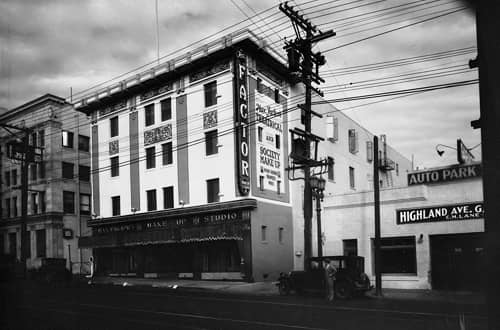
Above: Max Factor Make-up Studio before the redevelopment showing the Highland Avenue Garage on land that would be incorporated into the new building.

Above: The Max Factor Make-up Studio on North Highland Avenue designed by S. Charles Lee [1899-1990] as it would have appeared when the building reopened.
After the building and refurbishment program was complete, the studio reopened in a blaze of publicity.

Above: 1935 Red carpet opening of the refurbished Max Factor Studio on November 26th.
The main entrance of the building led up a small set of stairs to an oval reception room which opened into four make-up salons, one for each of the Max Factor types – Blondes, Brunettes, Redheads and Brownettes – each decorated in a different colour scheme.
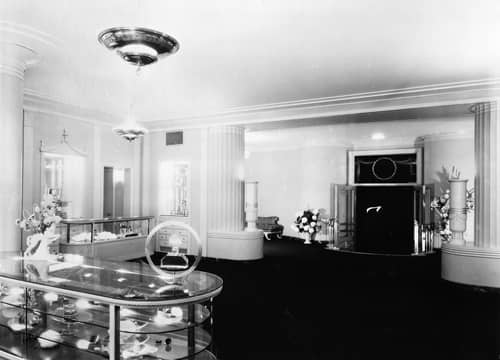
Above: 1935 Lobby of the Max Factor Make-up Studio looking towards the front door.
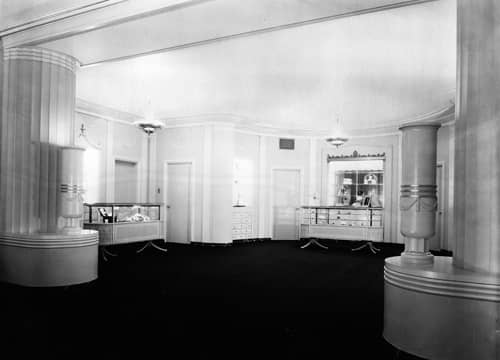
Above: 1935 Lobby of the Max Factor Make-up Studio looking away from the front door.
Behind the four make-up rooms were research and other laboratories. Offices, the hair department, manufacturing and packaging facilities occupied the floors above.
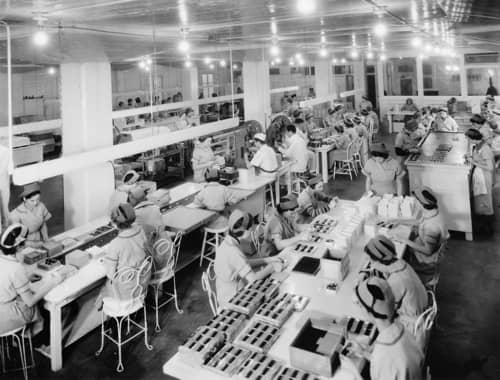
Above: 1936 Workers assembling and packaging a range of Max Factor products at North Highland Avenue including compact rouge (lower left) and cake mascara (lower right).
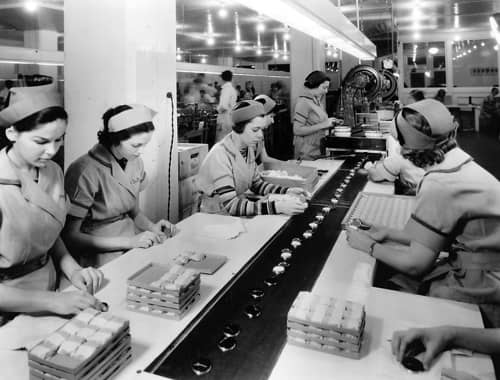
Above: 1936 Closer view of the compact rouge assembly line.
An adjacent building contained a face powder plant along with store rooms as well as loading and unloading docks.
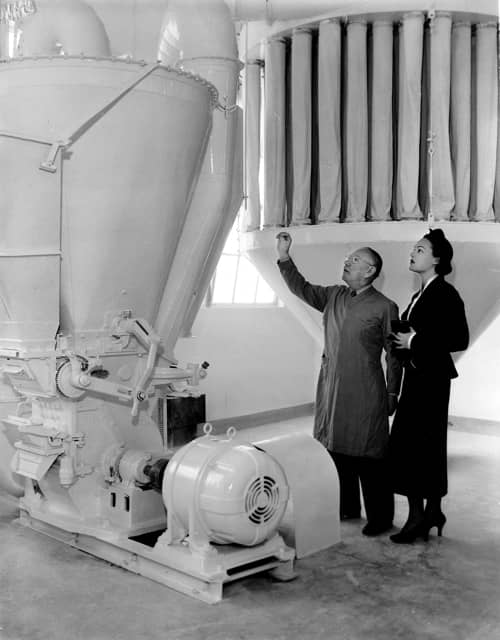
Above: 1935 Max Factor with Katherine DeMille [1911-1995] in the powder plant.
Overseas expansion
Max Factor had been selling is products overseas since the early 1920s. Its first overseas agency was opened in Britain in 1927 with a company established there in 1936. This was followed by France (1937), Canada and The Philippines (1940), and Mexico (1944).
Professional make-up
Max Factor continued to work closely with the motion picture industry and also took an interest in the developing medium of television. In 1929, the company supplied make-up for Technicolor Process 3 film and Multicolor film stocks and, in 1932, make-up for early black-and-white television.
See also: Max Factor and Televison
Max Factor also worked with the Westmore twins – Ern (Ernest) [1904-1968] and Perc (Percival) Westmore [1904-1970] – to develop ideas and techniques to make actresses look their best when filmed. Perc Westmore would use this work to develop his Corrective Make-up system at Warner Brothers-First National.
See also: The Ideal Face and Face Shapes
Ern Westmore came to work with Max Factor in 1932 but left when the House of Westmore was established in 1935. Two Max Factor employees went with him then, Leonard Dean Smith and Ismael R. Alvarez. The House of Westmore Salon of Beauty opened on April 16th, 1935, at 6638 Sunset Boulevard, Hollywood, well before Max Factor opened his refurbished Make-up Studio in November.
See also: House of Westmore
In 1935, Max Factor introduced Satin Smooth Liquid Foundation for the film industry, a liquid greasepaint in eleven Panchromatic shades (Nos. 21-31) matched with shades of Satin Smooth Powder.

Above: 1935 Max Factor Satin Smooth Liquid Foundation. The powder came in a glass jar with a perforated top that could be opened to dispense the powder then closed.
Other forms of Max Factor Panchromatic Make-up were also described as Satin Smooth and the term was later used to characterise a number of Max Factor Hollywood cosmetics, both make-up and skin-care.
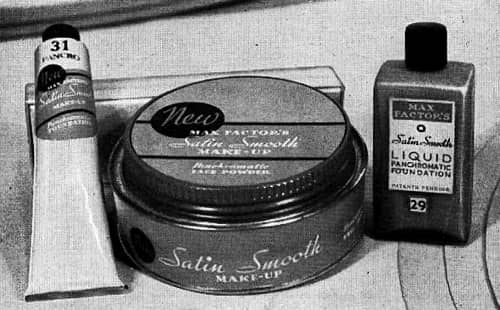
Above: 1938 Max Factor Satin Smooth Cream, Powder and Liquid Panchromatic Make-up.
See also: A Catalog of Max Factor’s Theatrical Make-Up (1938)
Pan-Cake
Developed for Technicolor film in 1936, Pan-Cake was first used in 1937 in the film ‘Vogues of 1938’ (Walter Wanger Productions). Its importance to the motion picture industry cannot be overstated. It provided a solution to the make-up problems associated with filming in Technicolor and it also marked an important step in the move away from greasepaint to modern forms of professional make-up.
After its success as a professional make-up, the company added Pan-Cake to its general consumer make-up range. This required modifications to Pan-Cake’s shade range to produce lighter tones. It sold phenomenally well both as a professional and as a general make-up. Sales soon outstripped the combined revenues of all other Max Factor cosmetics (Basten, 1995, p. 161) and this led to it being widely copied by other cosmetics firms.
See also: Pan-Cake Make-up
General cosmetics
Product lists from Max Factor show that the company released a number of new products and extended its make-up shade ranges during the 1930s. By 1940, the company had also dropped the term ‘Society Make-up’ in preference to the more marketable ‘Max Factor Hollywood’, a trademark the company registered in 1937.
1932 Product List (Society Make-Up, U.S.A.) included:
Make-up including Face Powder (Shades: White, Flesh, Rachelle, Natural, Olive, Brunette, Ochre, Sum’r Tan, Evening); Rouge (Shades: No. 12, 18, 24, Flame, Blondeen, Carmine, Raspberry, Natural Day); Lipstick (Shades: Light, Medium, Dark); Super-Indelible Lipstick (Shades: Flame, Vermillion, Carmine, Crimson); Lip Pomade (Shades: Light, Medium, Dark); Eye Shadow (Shades: Brown, Grey, Blue, Green); Eyebrow Pencil (Shades: Black, Brown); Masque (Shades: Black, Brown); Mascara (shades: Black, Brown, Blue); Powder Foundation (Shades: White, Flesh, Rachelle, Natural); and Make-Up Blender (Shades: White, Flesh, Rachelle, Natural).
Skin care cosmetics including Skin and Tissue Cream, Honeysuckle Cream, Cleansing Cream, Melting Cleansing Cream, Liquid Cleansing Cream, Astringent, Skin Freshener and Bleach Mask.
Assorted sundries including a Face Powder Brush and Brillox, a hair brilliantine.
Also see the booklet: The New Art of Society Make-up (1932)
1940 Product List (The New Art of Make-Up, U.S.) included:
Make-up including Face Powder (Shades: Rachelle, Rachelle No. 2, Natural, Brunette, Olive, Olive No. 2, Sum’r Tan, Flesh); Rouge (Shades: Flame, Blondeen, Carmine, Raspberry); Cream Rouge (Shades: Flame, Blondeen, Carmine, Raspberry); Tru-Color Lipstick (Shades: Orange Red, Light Red, Vivid Red, Medium Red, Natural Red, Deep Red), Eye Shadow (Shades: Brown, Grey, Blue), Eyebrow Pencil (Shades: Black, Brown), Masque/Mascara (Shades: Black, Brown), Eyelash Make-Up (Shades: Black, Brown); Pan-Cake Make-up (Shades: Cream No. 1, Cream No. 2, Natural No. 1, Natural No. 2, Tan No. 1, Tan No. 2); Invisible Make-Up Foundation; Astringent Foundation; and Make-Up Blender (Shades: Rachelle, Natural, Olive, Sum’r Tan).
Skin care cosmetics including Max Factor Cleansing Cream, Melting Cleansing Cream and Dry Skin Cream.
Assorted sundries including a Face Powder Brush and Brillox, a hair brilliantine.
Also see the booklet: The New Art of Make-up (1940)
Skin-care
The skin-care cosmetics included in the original Society line were fairly limited and aimed primarily at helping to prepare the skin for applying and removing make-up. At night, the skin was cleansed with Cleansing Cream (liquid or solid) or Lemon Cleansing Cream (liquid or solid) if it was oily. If the skin was dry, it could be improved by leaving Skin and Tissue Cream on overnight. In the morning, before applying make-up, the face was refreshed with Astringent, or Astringent followed with Honeysuckle Cream if the skin was oily.
Also see the booklet: The New Art of Society Make-up (1929)
There were minor changes to this routine during the 1930s. By 1932, Melting Cleansing Cream had replaced the earlier Cleansing Cream – plain or lemon – as the recommended cleanser for all skin types. However, in 1938, Max Factor introduced Normalizing Cleansing Cream, which was said to ‘agree’ with all skin types. By 1940, this new skin cleanser was simply referred to as Max Factor Cleansing Cream. Melting Cleansing Cream, which appears to have been a liquifying cleansing cream, remained in the range but was now usually only recommended for oily skin types.
Cleansing Cream: “[T]o remove every trace of make-up, and to thoroughly cleanse your skin. This perfectly balance cream will ‘agree’ with your skin, regardless of whether it is dry, oily, or normal. Caressingly soft, it dissolves quickly and cleanses rapidly. Apply thinly, massage thoroughly into the skin, and remove with tissue.”
Melting Cleansing Cream: “Apply at night to remove your make-up and cleanse your skin but do not leave it on overnight if your skin is oily. The swift action … is preferable for removing make-up from oily skin because it melts upon contact and can be removed immediately.”
See also: Liquefying Cleansing Creams
By 1940, Max Factor had also added a Dry Skin Cream allowing to company to further customise its skin-care routines for different skin types.
Care for a dry skin
AT NIGHT, cleanse the skin and remove the make-up with Max Factor Cleansing Cream. Apply Dry Skin Cream generously and leave on all night. AT MORNING refresh the skin with Skin Freshener. Protect the skin with Invisible Make-up Foundation.
Care for an oily skin
AT NIGHT, cleanse the face with Max Factor Cleansing Cream. Apply Astringent generously. AT MORNING, apply Astringent again. If the skin is very oily use Astringent Foundation; otherwise use Invisible Make-up Foundation.
Care for a normal skin
AT NIGHT, cleanse with Max Factor Cleansing Cream. Then apply a light application of Dry Skin Cream. AT MORNING refresh the skin with Skin Freshener and protect your skin with Invisible Make-up Foundation.(The new art of society make-up, 1940)
Max Factor did make recommendations for treating common skin-care problems such as blackheads, freckles, coarse pores, oily nose, dark circles under the eyes, wrinkles, scars, suntan and freckles but these were perfunctory. It is telling that Max Factor brochures generally dealt with these issues under the heading ‘If you have a make-up problem’ and it did not sell specialist pore creams, wrinkle creams and the like, commonly available from salon-based beauty firms like Helena Rubinstein, Elizabeth Arden and Dorothy Gray.
Make-up
There were a number of additions to the Society/Max Factor Hollywood make-up range in the 1930s the most important of which was Pan-Cake. Extra shades added to exisiting make-up lines were still organised according to the Color Harmony principles Max Factor had outlined in the 1920s.
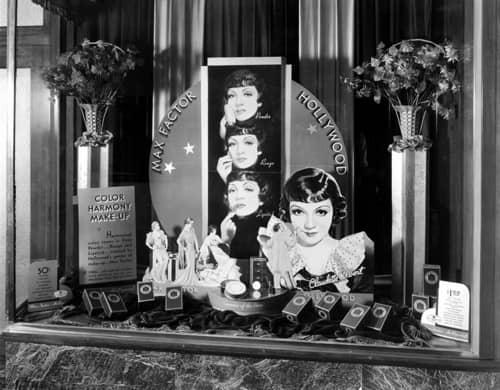
Above: Max Factor window display for Color Harmony Make-Up featuring Claudette Colbert [1903-1996].
Lipstick and rouge
The original Society range included a Lipstick and Lip Pomade, each in three shades – Light, Medium and Dark. In 1931, Max Factor introduced the Super-Indelible Pyramid Lipstick packaged in an octagonal case. Subsequently, it was known more simply as the Super-Indelible Lipstick.
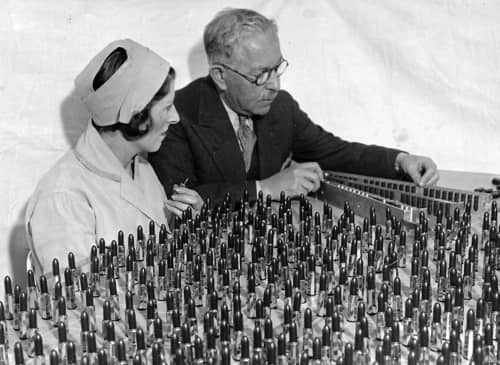
Above: 1932 Max Factor and Ray Judd examining Super-Indelible Lipsticks. This photo appears to have been taken in the factory as a back drop has been hung to hide other parts of the plant.
Super-Indelible Lipstick: “The perfect lipstick! Super-Indelible! Colors alive with beauty. Creamy! Soothing and protecting. Satin-smooth!” Shades: Flame, Vermillion, Carmine and Crimson.
See also: Test Your Color in Lip Make-up
By 1937, Max Factor had added Special Light, Special Medium and Red Raspberry to the Light, Medium and Dark shades of its original Society lipstick. Then, in 1938, the company introduced Tru-Color Lipstick, another indelible packaged in an elegant gold case.
Tru-Color Lipstick: “[G]ives the lips a lifelike red tone, with no purple or bluish undertones. It’s non-drying, but indelible! Eliminates ugly ‘lipstick line’.” Shades: Orange Red, Light Red, Vivid Red, Medium Red, Natural Red, and Deep Red.
Max Factor Rouge was produced in both cream and compact powder forms through the decade but there was some adjustment to shades. In 1932, rouge came in No. 12, No. 18, No. 24, Blondeen, Raspberry, Natural, and Day shades the same shades used in Max Factor’s professional make-up where No. 12 was also known as Light Theatrical, No. 18 as Theatrical. By the end of the decade, the shade range sold to the general public had dropped to four: Flame, Blondeen, Carmine, and Raspberry.
Foundation and powder
The Society Make-up range included a Powder Foundation Cream in White, Flesh, Rachel and Natural shades with Light and Dark shades of Sum’R Tan (Summer Tan) added in 1929. Its formulation is unknown to me but it seems logical that it was a type of vanishing cream, a common basis for face powder in the 1920s and 1930s.
See also: Vanishing Creams
Max Factor Powder Foundation Cream was applied under powder unless the skin was very oily, in which case Max Factor recommended switching to Honeysuckle Cream, later referred to, or replaced by, Max Factor Astringent Cream.
In 1937, Max Factor added Invisible Make-up Foundation, a colourless foundation. This sounds impressive but it should be remembered that a plain vanishing cream could also be thought of as ‘invisible’.
Invisible Foundation: “It’s different from that [sic.] you think. You can see it . . but on your skin it disappears. You can feel it . . but on your skin it blends into nothingness . . Yet, it holds make-up on hours longer. It protects the skin against weather, sun and dust . . and it imparts a velvety smoothness.”
The Max Factor Society Face Powder came in White, Flesh, Natural, Rachel, Brunette, Olive, Ochre and Evening shades with Sum’R Tan (Summer Tan) added in 1929. New shades introduced after that tended to be darker, a reflection of the increased level of suntanning and, by 1943, the Max Factor Hollywood Face Powder came in Rachel, Rachel Rose, Rachel 2, Olive, Olive 2, Natural Rose, Sum’R Tan (Summer Tan), and Tan Rose. The powder was to be patted on with a puff, not rubbed, with the excess removed with a powder brush.
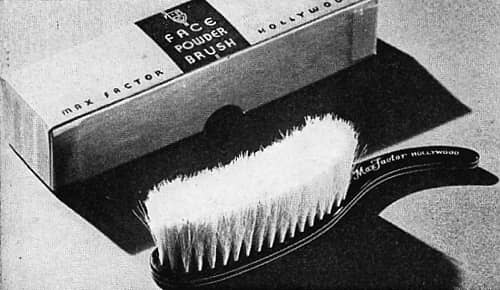
Above: Max Factor Powder Brush.
Max Factor recommended that women make up their neck, arms and shoulders to match the tone of their face with Make-Up Blender. This was applied thinly and evenly in long, straight strokes using a sponge or pad soaked in the Blender.

Above: Tala Birell [1907-1958] using what appears to be Make-up Blender on her neck.
The product has its origins in the Supreme Liquid Whitener which Basten claims was released for general use in 1917. This suggests it was a type of Wet White but produced in White, Flesh, Rachelle and Natural shades.
Also see: Liquid Face Powders
As mentioned earlier, Max Factor released Pan-Cake as a general make-up in 1938.
Pan-Cake: “It makes the skin look youthful, lovely, smooth as velvet. It hides every tiny complexion fault, and … stays on for hours without re-powdering.” Shades: Cream No. 1, Cream No. 2, Natural No. 1, Natural No. 2, Tan No.1, and Tan No. 2 with Cream Rose, Natural Rose, and Tan Rose added by 1944.
As with face powder, Max Factor suggested applying Pan-Cake over Invisible Make-Up Foundation on normal or dry skins or Astringent Foundation on oily skin types. Powder could also be applied after Pan-Cake was used but not all women did this.
Eye make-up
Max Factor had been supplying the entertainment industry with mascara, eye shadow, eyebrow pencils and false eyelashes for years and many of these were also sold as general make-up. The Eyebrow Pencil, which had its origins in the professional Dermatograph Pencil, came in Black and Brown; Eye Shadow in Brown, Grey and Blue; and the Mascara, based on the professional Masque used to colour head hair, beards and eyelashes, came in Black and Brown.
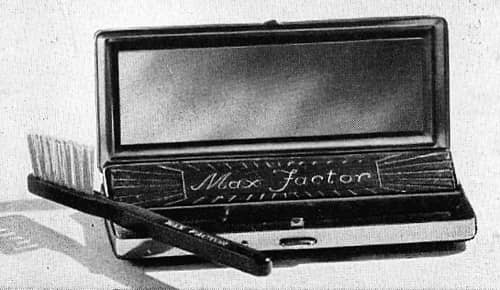
Above: Max Factor Mascara in a gold-and-black metal case was a more elegant alternative to the earlier Max Factor Masque.
Make-up routine
The routine suggested by the company for applying its Society Make-Up was as follows:
First—Cleanse the skin with Max Factor’s Cleansing Cream, removing every sign of make-up each night before retiring. Always have the skin absolutely clean before using make-up.
Second—Close the pores and refresh the skin with Max Factor’s Astringent.
Third—Apply a small dab, half the size of a pea, of Max Factor’s Make-up Foundation Cream to forehead, cheeks and chin. The less used, the better the effect. Dip finger tips in cold water, and blend the foundation Cream into the skin until it disappears from the surface. Keep the fingers moist with water. Work away from the center of the face, using a one-way (not circular) stroke.
If Your Skin is Oily Do Not use foundation cream, but use Max Factor’s Honeysuckle Cream. …
Fourth—Apply Max Factor’s Eye Shadow lightly to the upper lid only. Blend it in very faintly from the eyelash to eyebrow.
Fifth—Pat Max Factor’s Rouge on lightly at the highest spot of the cheek, just below the cheek-bone. blend it gently into the skin with the finger tips, shading the color downward to the full part of the cheek. Blend in the edges of the rouge so as not to leave any lines of demarkation.
Sixth—Pat Max Factor’s Face Powder on profusely with a powder puff, covering the entire face. Then remove surplus with Max Factor’s Face Powder Brush. This method clears all crevices of excess powder, prevents streaking and caking. (Never rub powder on.)
Seventh—With Max Factor’s Dermatograph Pencil, shape the eyebrows, fill them in, or give them a more pronounced color and sheen.
Eighth—Apply Masque to the upper lashes by brushing upward; to the lower lashes by brushing downward. Moisten brush only slightly to prevent spotting and smearing.
Ninth—Use Max Factor’s Lipstick sparingly. Dry the lips first, and then apply lipstick evenly. Rub it well toward the inside of the mouth to eliminate rouge line where the lips meet. Then moisten lips. Use Lipstick for moist lips; Lip Pomade for dry.
Tenth—Apply Max Factor’s Make-Up Blender to the neck, arms and hands. Smooth it on thinly and evenly from the neck and shoulders to the tips of the fingers, using a downward, one-way stroke (not circular); then rub into the skin until dry.
Eleventh—Impart a lustrous sheen to your hair with a sprinkling of Brillox as a final touch of perfect grooming.
SPECIAL INSTRUCTIONS FOR EVENING
In the evening, at social functions, dances and in cafes, you will find that your natural daytime make-up will be toned down by the artificial lights. Therefore I recommend a more enlivening color harmony for each type.(The new art of society make-up, 1928, pp. 22-23)
Booklets put out by Max Factor through the 1930s also contained detailed instructions on the best way to apply lipstick, rouge, face powder and eye make-up, which included some basic contouring techniques used by stage and screen make-up artists.
Fragrances
The first perfume sold by Max Factor was Le Parfum Max (1925) made by the French firm Les Fourrures Max. In 1933, Max Factor hired Dr. Anthony T. Frascati – known for his research into distilling perfume essences from fruits – as a perfumer and resident chemist. He appears to have made up some individual fragrances for movie stars while at Max Factor, but does not seem to have developed any ‘parfums’ for general sale during his time there as the company’s next two perfumes, Cocoanut Grove and Trocadero were released in 1938, two years after he had left.
Frank Factor was credited as the main ‘nose’ of the Factor family but all the fragrances sold by Max Factor up until 1954 appear to have been imported.
Generational change
Unfortunately, Max Factor did not live long enough to see how successful Pan-Cake would become. His death in 1938 – possibly brought on by the injuries he sustained when hit by a delivery truck, combined with the stress of a death threat he received while travelling in Italy in 1938 to visit the newly opened Cinecittà Studios – meant that the company passed into the hands of the next generation.
The death of the company founder meant that management of the firm passed to the second and third generation of Factors and their marriage partners – including Frank Factor, Sidney Factor, Louis Factor, Davis Factor and Max Firestein – many of whom had been with the company for decades.
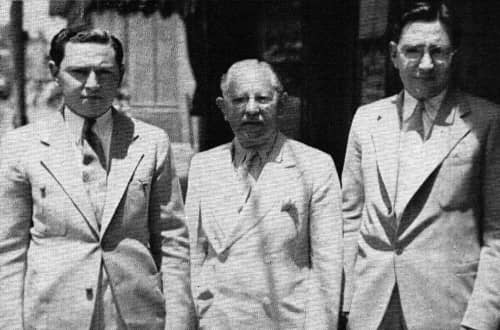
Above: 1934 Frank Factor, Max Factor and Davis Factor.
Francis ‘Frank’ Factor, who had worked most closely with his father on product development, changed his name to Max Factor Jr. to carry on the Max Factor name. With Frank as company president and his older brother Davis as chairman of the board, the company continued on much as before.
Wartime
America did not enter the Second World War until December 1941 but events in Europe made life difficult for the company after 1939. Unfortunately, I have no records of what happened to the Max Factor Studio established at 11 Rue Royal, Paris in 1937.
A British company had been founded in January, 1939 to manufacture Max Factor cosmetics in Britain and it continued on throughout the war. Its sales were affected by limitations in supplies and tax increases and some products were withdrawn from its inventory. In both Britain and America packaging became a major problem and women were encouraged to use refills sold in cardboard boxes. In Britain, for example, Pan-Cake was only available as a refill. A number of products also went into wartime packaging. For example, in the Unted States, Tru-Color Lipstick had its metal top replaced with white plastic from 1943 to 1946.
Before America entered the war, the company had established branches in the Philippines and Canada (1940). The branch in the Philippines was probably lost after the Japanese occupied the islands in 1942 but the company continued to expand in the Americas, opening branches in Cuba (1942) and Mexico (1944).
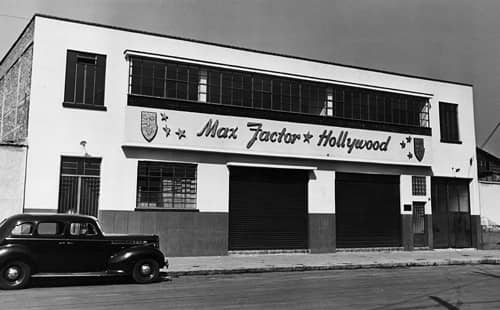
Above: Max Factor Mexico City, Mexico.
Max Factor also made a number of contributions to the American war effort including manufacturing camouflage make-up for the U.S. Marine Corps.
Timeline
| 1930 | South Hill store closed. International Division established. New Products: Lip Gloss. |
| 1931 | Max Factor Sales Corporation becomes Sales Builder. New Products: Super-Indelible Lipstick. |
| 1932 | New Products: Television make-up for B/W Television.
|
| 1933 | Max Factor Manufacturing Corporation established in California. Max Factor opens a third plant devoted to making dry rouge, compacts, mascara and lipsticks. |
| 1935 | The renovated and extended Make-up Studio opens at 1666 North Highland Avenue, Hollywood. New Products: Satin Smooth Liquid Foundation and Powder. |
| 1936 | Max Factor hit by a delivery truck on North Highland Avenue. Max Factor Hollywood and London (Sales), Ltd. established with offices at 16 Old Bond Street, factory at Park Royal and salon at 49 Old Bond Street. |
| 1937 | Max Factor Studio established at 11 Rue Royal, Paris. London salon moved to 16 Old Bond Street. New Products: Invisible Make-Up Foundation; Pan-Cake make-up; and Sun Tan Oil. |
| 1938 | New Products: Tru-Color Lipstick; and Normalizing Cleansing Cream. |
| 1939 | Max Factor Manufacturing Corporation dissolved. Max Factor & Co. Ltd. founded in London. |
| 1940 | Max Factor established in Manila, The Philippines and Canada. |
| 1941 | Max Factor established in Cuba. |
| 1944 | Max Factor opens a buying office at 730 Fifth Avenue, New York; and a branch in Mexico. |
Continue to: Max Factor (1945-1960)
First Posted: 19th August 2013
Last Update: 28th July 2023
Sources
75 years of Max Factor. (1984). Manufacturing Chemist. January, 49.
Anderson, K. (2001). “Go West”: The representation of Los Angeles in silent film comedy [Electronic version]. Spectactor. 21(1). 82-90.
Basten, F. E. (1995). Max Factor’s Hollywood. Glamour, movies, make-up. Los Angeles: General Publishing Group.
Basten, F. E. (2008). Max Factor: The man who changed the faces of the world. New York: Arcade Publishing.
Factor, M. (1928). Movie make-up. American Cinematographer, 10(1), 8, 25.
Factor, M. (1937). Standardization of motion picture make-up. Journal of the Society of Motion Picture Engineers, 28(1), 52-62.
Lecture for Max Factor Hollywood art school of make-up [Booklet]. (1940). Los Angeles: Sales Builders, Inc.
MacCulloch, C. (1930). Seen in their true colors. Motion Picture. 39(4), 38, 88, 104.
The new art of society make-up [Booklet]. (1928). Hollywood: Max Factor Studios.
The new art of society make-up [Booklet]. (1929). Hollywood: Max Factor Studios.
The new art of society make-up [Booklet]. (1937). London: Max Factor Studios.
The new art of make-up [Booklet]. (1940). Toronto, Canada: Max Factor Hollywood.
Peiss, K. (2007). Hope in a jar: The making of America’s beauty culture. New York: Henry Holt and Company.
Young, J. (1905). Making up. A practical and exhaustive treatise on this art for professional and amateur. New York: M. Witmark & Sons.
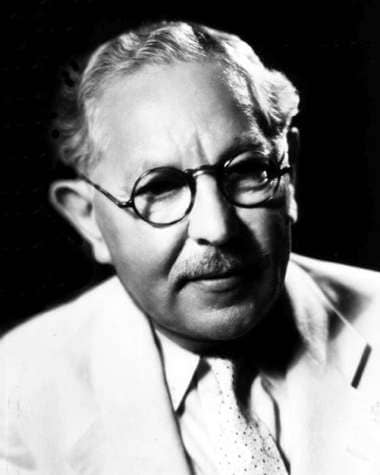
Max Factor [1872-1938].
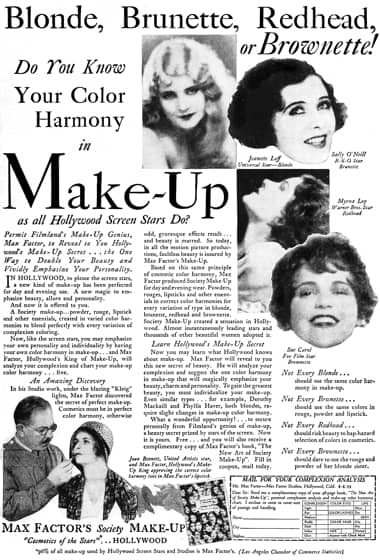
1930 Max Factor Society Make-up.
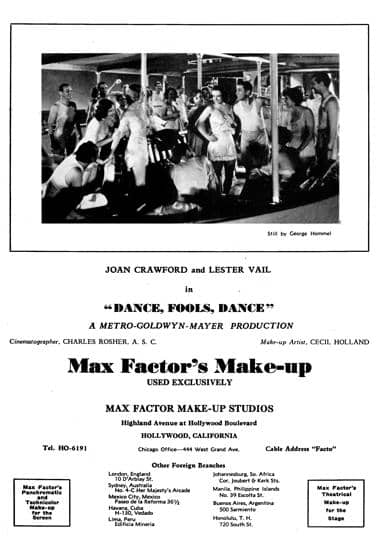
1931 Industry advertisement for Max Factor Panchromatic and Technicolor Make-uUp.
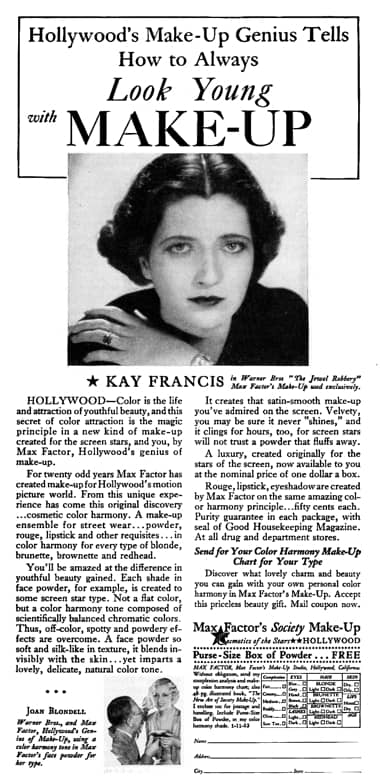
1932 Max Factor Society Make-up. It has sometimes been said that Max Factor was the first person to apply the word ‘make-up’ to decorative cosmetics. Although this is not correct, he can be credited with bringing the term into more general usage.
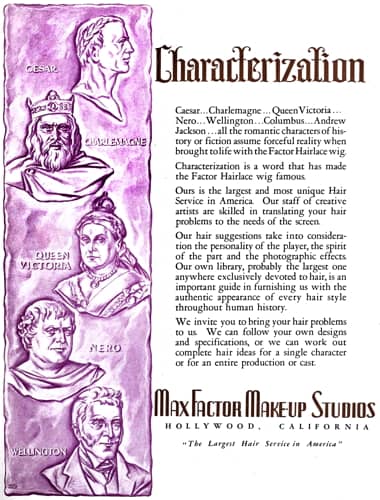
1932 Trade advertisement for the Max Factor Make-up Studio.
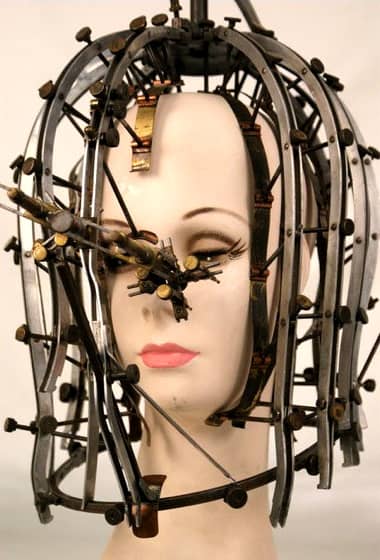
Max Factor Beauty Calibrator. Developed in 1932 it was supposed to measure how far a person’s features differed from the ‘ideal face’.
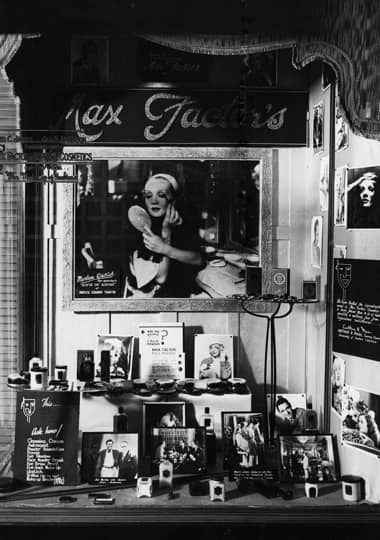
1933 Max Factor window display.
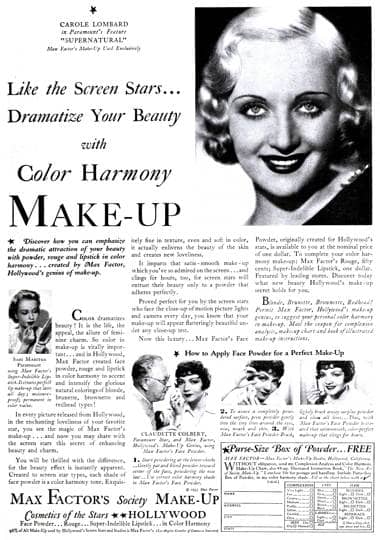
1934 Max Factor Society Make-up. Max Factor promoting a Paramount picture ‘Supernatural’ starring Carol Lombard and receiving reciprocal endorsement all for the price of US$1.00.
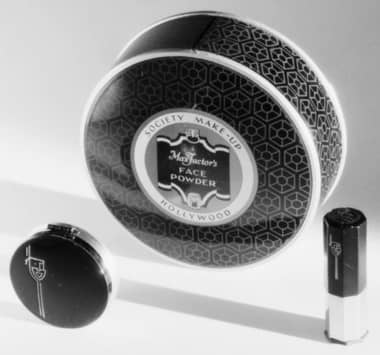
Above: 1934 Max Factor Society Compact Rouge, Face Powder and Super-Indelible Lipstick.
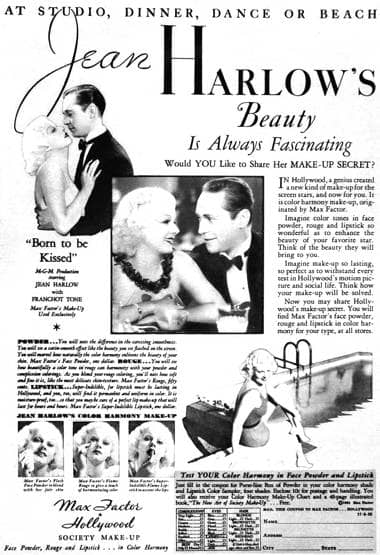
1934 Max Factor Society Make-up. The prominence of the Society Make-up brand has been reduced and Max Factor’s relationship with Hollywood is strengthened. The Max Factor make-up recommended for Jean Harlow is listed to allow readers to match her look at home.
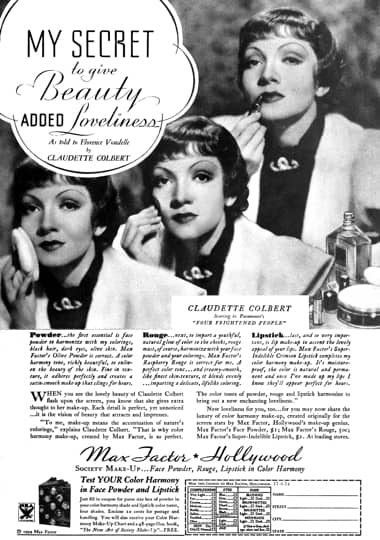
1934 Max Factor Society Make-up. Claudette Colbert endorsement for Max Factor.

1935 Max Factor Society Make-up.
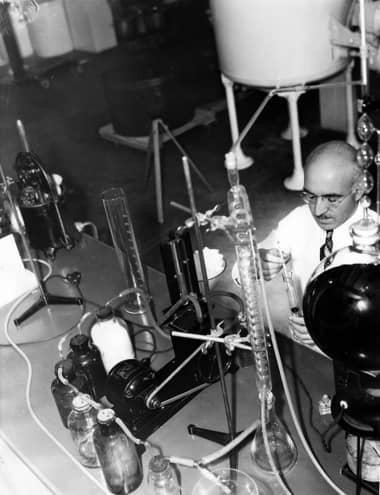
1935 Dr. Anthony T. Frascati [1893-1981], perfumer and resident chemist for Max Factor between 1933 and 1936.
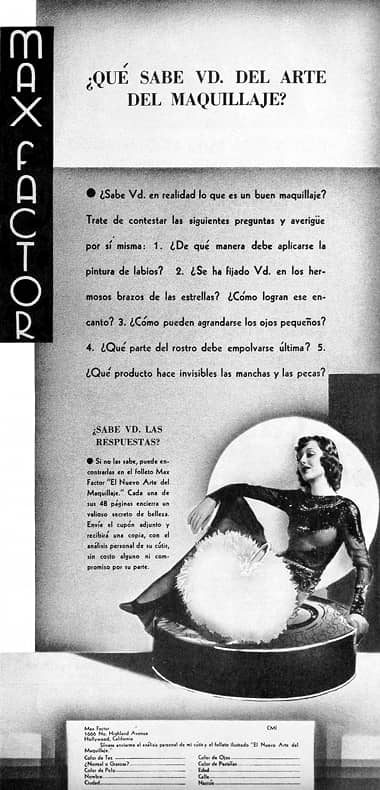
1935 Max Factor Hollywood.

1935 Max Factor Hollywood.
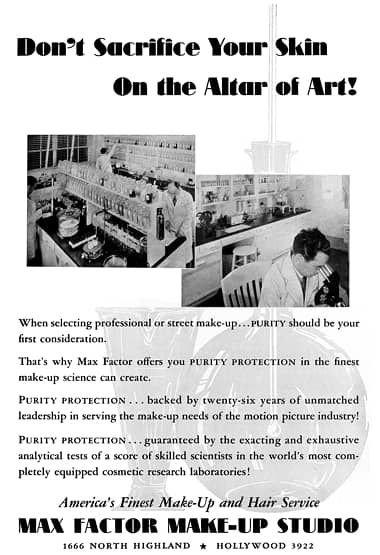
1936 Industry advertisement for Max Factor Make-Up Studio, Hollywood.
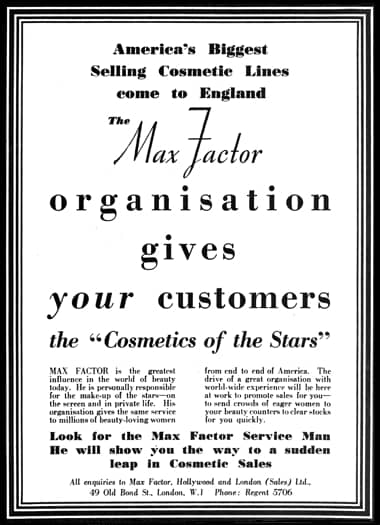
1936 Industry announcement for Max Factor arriving in England.
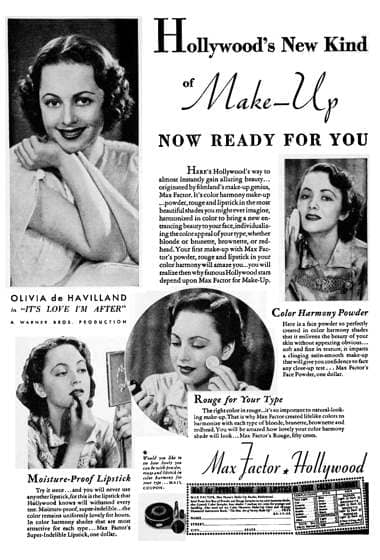
1937 Max Factor Hollywood. The Society Make-up brand has disappeared and there is a greater stress on Hollywood and the products in the line.
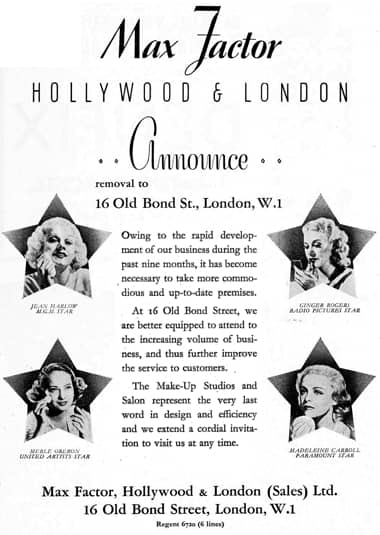
1937 Max Factor moves to 16 Old Bond Street, London.

1937 Max Factor applying eye make-up. Publicity shots like this were commonly used during the 1920s and 1930s as were photographs of Max Factor in his laboratory. Frank Factor occasionally posed for similar shots after his father’s death.
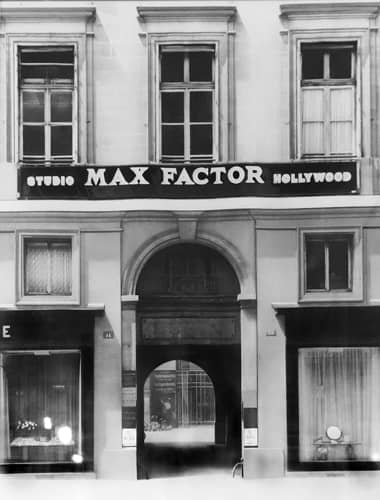
Max Factor Hollywood Studio established at 11 Rue Royal, Paris in 1937.
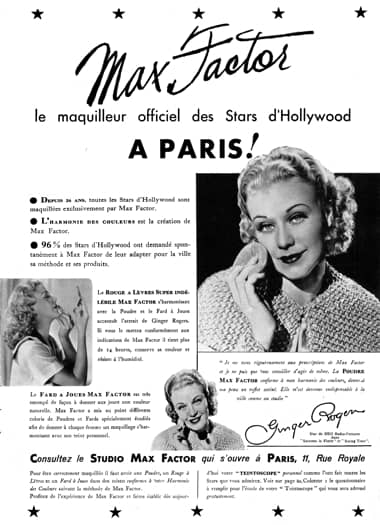
1937 Max Factor arrives in Paris.
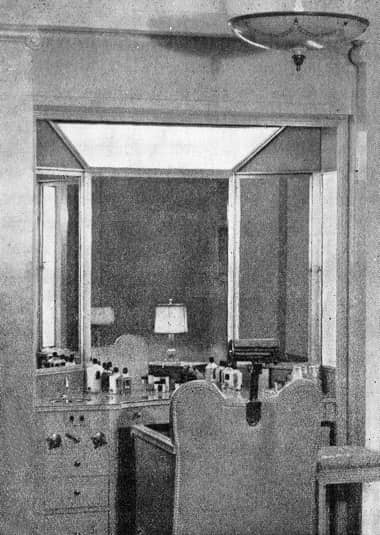
1937 Make-up cubicle in the Hollywood salon.
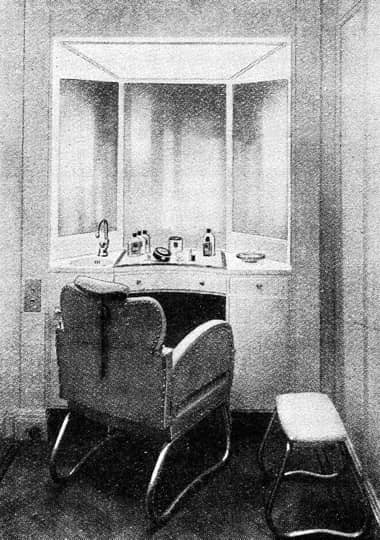
1937 Make-up cubicle in the London salon.
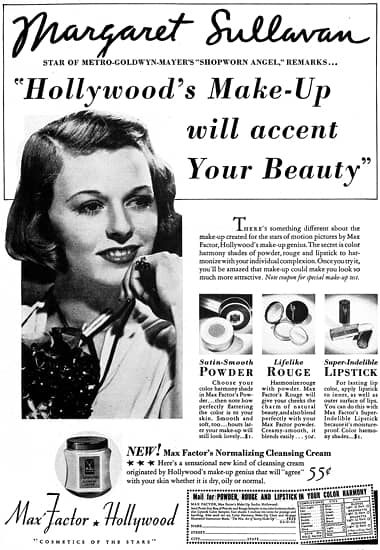
1938 Max Factor Normalizing Cleansing Cream.
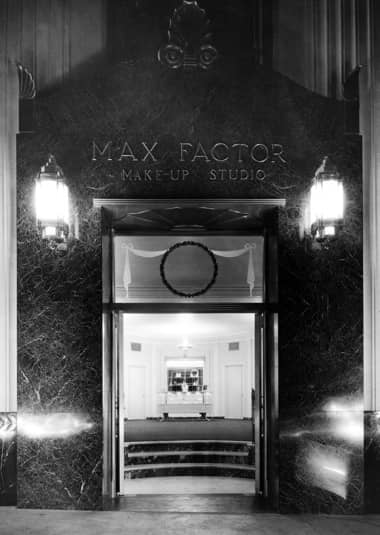
1938 Green marble entrance to the Max Factor Make-up studio with a view into the lobby.
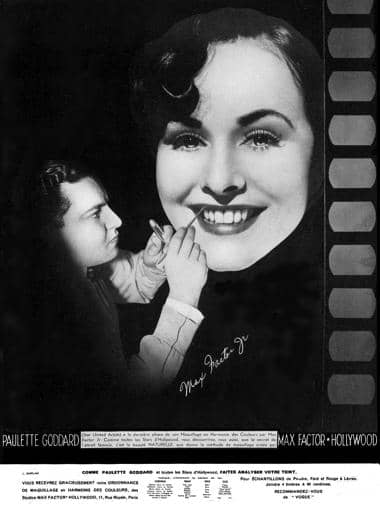
1939 Max Factor French advertisement featuring Frank Factor, now known as Max Factor Jr.
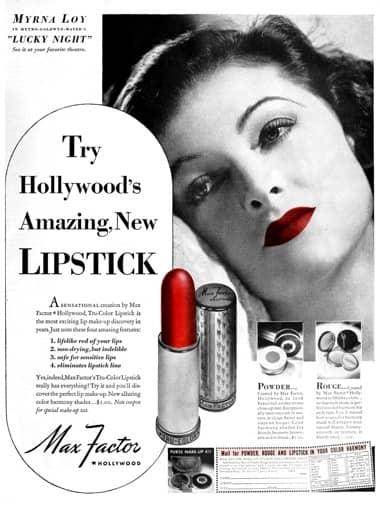
1939 Max Factor Tru-Color Lipstick.
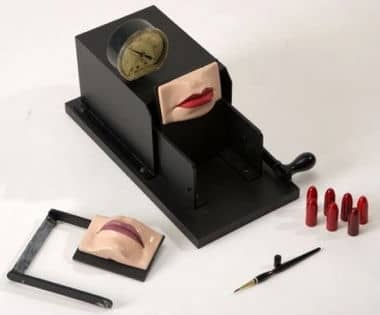
Max Factor Kissing Machine. Developed in 1939 it was used to test the indelibility of Tru-Color Lipstick.

1940 Max Factor Melting Cleansing Cream, Face Powder, Honeysuckle Cream and Super-Indelible Lipstick (Britain).
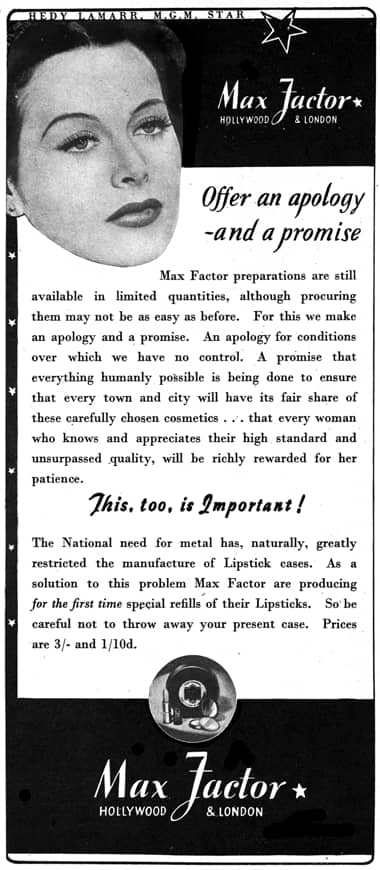
1940 Max Factor Hollywood & London.
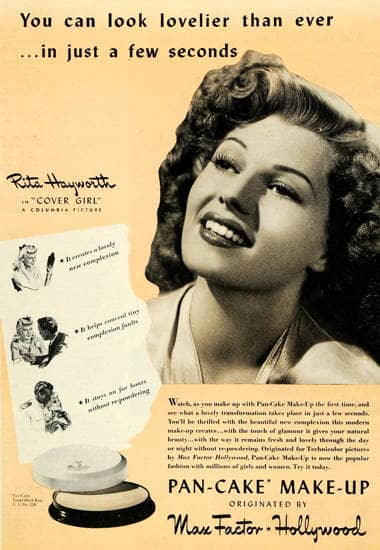
1943 Max Factor Pan-Cake Make-up. Shades included Amber No. 1, Amber-Rose, Amber No. 2, Cream-Rose, Cream No. 2, Natural No. 1, Natural-Rose, Natural No. 2, Tan No. 1, Tan-Rose and Tan No. 2.
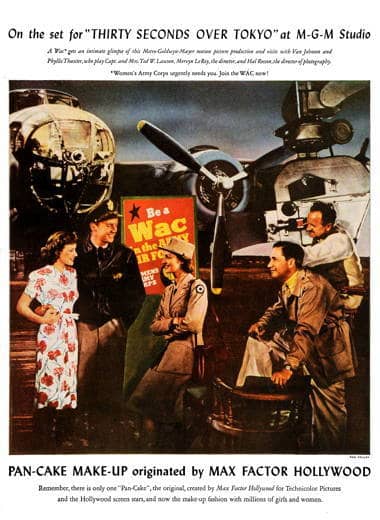
1944 Max Factor Pan-Cake Make-Up.
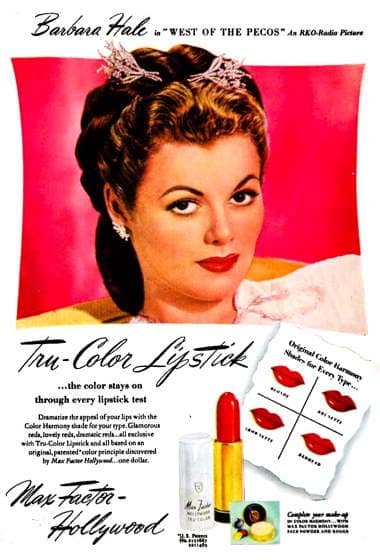
1945 Max Factor Tru-Color Lipstick. Developed in 1939 – presumably with the indelible dyes the company had patented in the same year (U.S. 2,157,667) – it was tested using the Kissing Machine. The lipstick has a top made with white plastic rather than metal. This war-time packaging was introduced in 1943 and remained in place until 1946.
